Yves here. We were among those to point out, relatively early, that Russia would dictate terms when the Ukraine war ended. But John Helmer was first to recognize that de-electrification was the leverage point in this campaign. Turning out the lights, as much as they will need to be, is looking to be the mechanism to force Ukraine’s capitulation.
Helmer expands on his theme of how the electric war has become central, even if the battlefield fight also continues.
By John Helmer, the longest continuously serving foreign correspondent in Russia, and the only western journalist to direct his own bureau independent of single national or commercial ties. Helmer has also been a professor of political science, and an advisor to government heads in Greece, the United States, and Asia. He is the first and only member of a US presidential administration (Jimmy Carter) to establish himself in Russia. Originally published at Dances with Bears
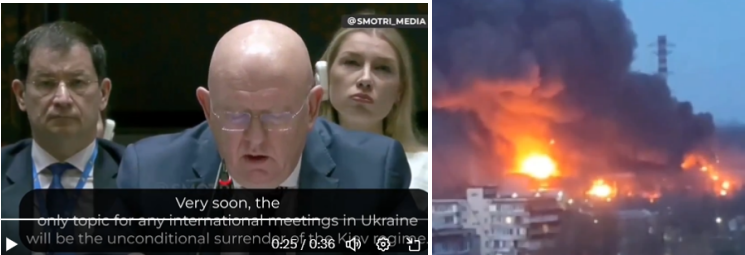
It was a relatively bright day, November 21, 1920, when Vladimir Lenin, having won the civil war and driven off the American, British, French, Canadian, and Australian invasion forces, announced: “Communism is Soviet power plus the electrification of the whole country, since industry cannot be developed without electrification.”
Come November 2024 it will be a century and four years to count what Lenin meant, and how Russia is proving itself against everything which the military industries, special forces, weapons, intelligence so-called, operations, and plans of the old invasion coalition, plus Germany, can throw at it. So on November 21, 2024, it will be time to revise Lenin’s maxim to read: Russia is military power plus the de-electrification of the countries which attack it.
This is electric war.
To make the war aim unambiguously clear, President Vladimir Putin ordered his ambassador to the United Nations (UN), Vasily Nebenzya (lead image, left), to read out a paper at his desk in the UN Security Council chamber on April 11: “very soon, the only topic for international meetings in Ukraine will be the unconditional surrender of the Kiev regime.”
Note what the terms “unconditional surrender of the Kiev regime” mean: total military defeat of the Ukrainian, American, British, French, Polish, and other forces on the Ukrainian territory and in the air surrounding; surrender of the municipal administrations of the east-bank cities, including Kharkov, Dniepropetrovsk, and Odessa; disarmament and demilitarization of the territory between Kiev and the Polish border; exit of every member of the regime, starting with Vladimir Zelensky.
This is an ultimatum without alternatives for either Moscow or Kiev. In electric war, are there any alternatives?
Nebenzya was making his announcement on the evening of Thursday, April 11, Kiev time. In the time it took for his text to be drafted, edited by the Foreign Ministry, authorized at the Kremlin, and Nebenzya given the go-ahead, it had been only a few hours after the lights of Kiev went out when the Tripolskaya power station was destroyed by a new Russian missile, the X-69 (lead image, right).
THE GEOGRAPHY OF TARGETING IN THE ELECTRIC WAR TO DATE
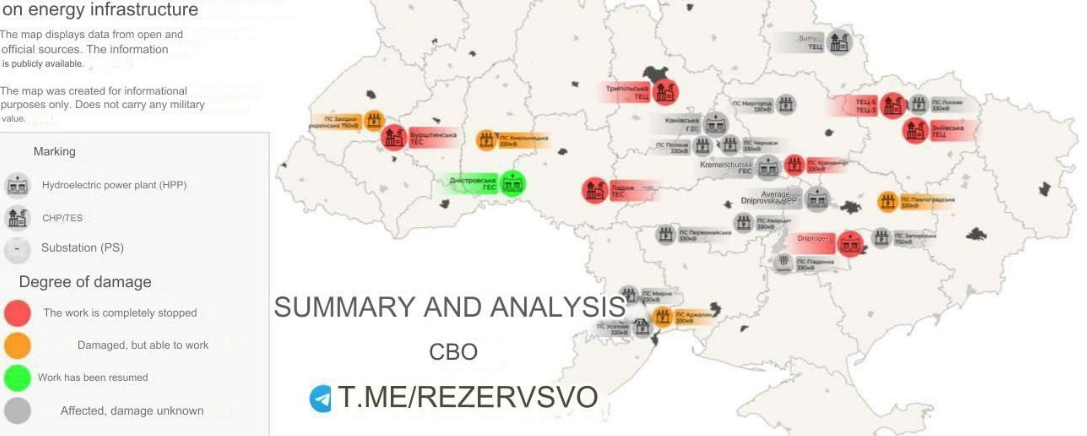
Click to enlarge key and identify locations: https://t.me/rezervsvo/53515
The strike against the Tripolskaya plant was carried out by X-69 missiles fired by Su-34 or Su-35 aircraft flying at a range of up to 400 kilometres from the targets. The aircraft were in Russian airspace, out of range of Ukrainian Patriot and other air defence batteries; the missiles, however, penetrated the air defence screen around Kiev and could not be intercepted. Source: https://t.me/s/Slavyangrad
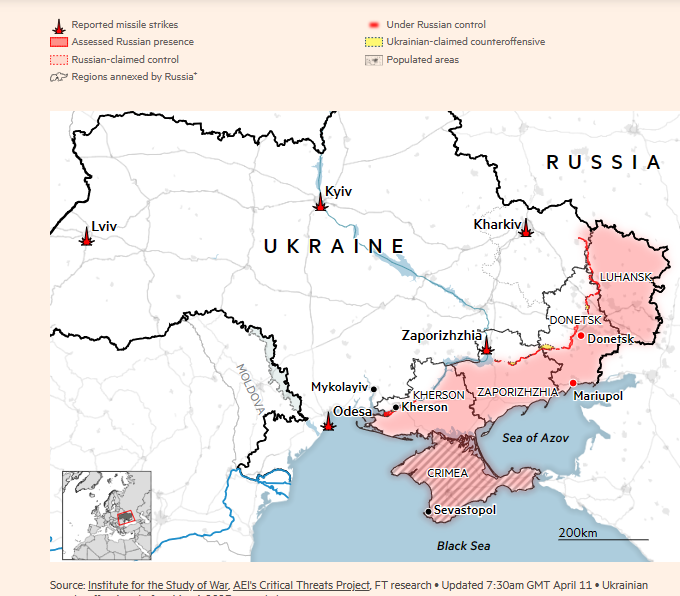
Source: https://www.ft.com/
Note the single, tiny yellow blip southwest of Donetsk which the Anglo-American mapmaker calls “Ukrainian claimed counteroffensive”.
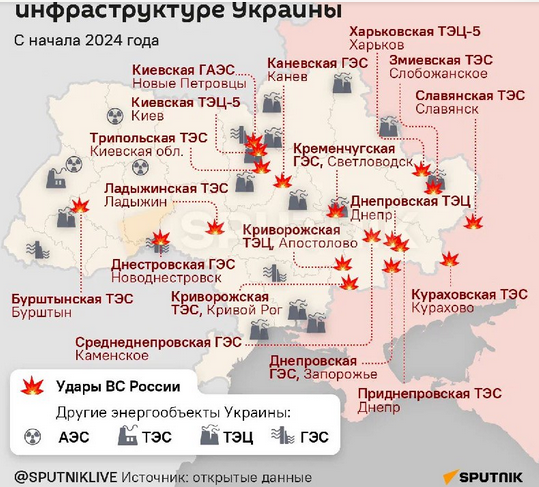
As of April 10, 2024: Source: https://t.me/sputniklive/78749
Boris Rozhin, whose Colonel Cassad military blog broadly represents General Staff thinking, reports the operational breakthrough demonstrated on April 11, and explains what the maps of current targeting foreshadow for the next round of strikes, and the rounds after that. Rozhin republishes his analysis from RT, the state media organ.
“By the evening of April 11, Ukrainian sources reported that air-launched X-69 missiles could be used to hit the Tripolskaya TPP [Thermal Power Plant]. So far, there is no confirmation of this information, but it is worth studying these missiles in more detail. Their range is almost 20 times less than that of the X-101 missiles [equivalent to about 250-500 kilometres], the carriers of which are strategic aircraft of the Aerospace Forces [Tu-95]. In their [X-69] function, they are closer to the foreign [Anglo-French] Storm Shadow/SCALP missiles, which are being attempted for strikes on the Crimean Bridge. The [X-69’s] long range of the 300 km could be enough if the launches of missiles were carried out from the territory of the Bryansk region. If the use of missiles is confirmed in the future, it will mean that no energy facility of the Ukraine on the Dnieper River can work safely, and the strike capabilities of the Aerospace Forces have multiplied.” https://t.me/rt_russian/197065
“Several factors have led to the weakening of the air defence in Ukraine, among which in the first place is the disproportionately high consumption of expensive anti-[aircraft] missiles SAMP-T, and Patriot, as well as daily losses of the foreign air defence systems near the front line. They have been deployed there to prevent Russian aircraft, or at least reduce their activity, but as a consequence, the foreign air defence systems themselves have become the target. And so the circle is closed — medium-range air defence systems cannot be placed on energy facilities now due to the risk of destruction; in the event they are destroyed, the West is in no hurry to replace the launchers and radars. As a result, the key energy facilities remain unprotected; it becomes easier to hit them; and for combined strikes it is no longer necessary to use [Russian] strategic aviation, as it was at the beginning of the SVO or throughout the past year. These circumstances allow the Russian Defense Ministry to reduce the consumption of long-range X-101 missiles, and open up for the General Staff the opportunity to expand the operational horizon in striking, and consider the following global steps, for which long-range means of destruction will be required.”
“What goals can be affected after Tripolskaya? If you compare the range of the X-69 missiles with the location of energy facilities on the Dnieper, you can find that due to the shortage of air defences, the presence of cheap cruise missiles, and the large number of combatants from the Russian side, you can organize a massive strike on any target in the central part of Ukraine. It is noteworthy that a significant part of the TPP [thermal power plant], CHP [combined heat and power plant], and HPPs [hydroelectric power plant] on the Dnieper have already been attacked once or several times. But with the use of the X-69, the cost of which is several times less than X-101/X-555, the destruction of Ukraine’s energy infrastructure can reach a fundamentally new level.”
“At the same time, the cumulative effect of the blows continues to shake the Ukrainian energy network: the sudden loss of 1.8 GW of generation against the background of the destruction of the Tripolskaya thermal power plant and the general shortage of electricity is a serious and unsolved problem for the foreseeable future. There are not so many partially functioning and as yet not fully destroyed targets; three of them – Zmievskaya, Pridneprovskaya, and Kryvorizhska [Krivoy Rog] are now within reach of the X-69 missiles. For the final destruction of similar facilities in the west of Ukraine (Burshtyn and Dobrotrytskaya TPP) a combined missile strike with the use of long-range X-101 can be carried out.”
For a guide to the measurement units of electricity generation and consumption, click to read.
MAP OF LOCATIONS OF UKRAINE POWER GENERATING PLANTS BY TYPE
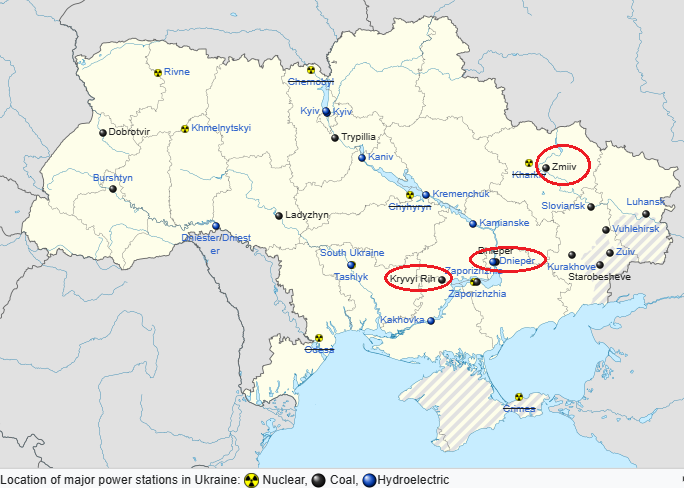
Source: https://en.wikipedia.org
“Given the fact that the Thermal Power Plants (TPP), as well as the hydropower plants [HPP], in the Ukraine play an important role in the system and have played the role of the energy balancer, their destruction will lead to the fact that there will be no stable electricity in the electricity system of the eastern and central part of the Ukraine. And without that it is impossible not only for industry to function, but also any normal life, not to mention serious military capabilities.”
The Ukraine has published electricity capacity levels before the war reaching their peak on January 25, 2022 — according to Ukrenergo figures, reported by the International Energy Agency (IEA) — of 21.13GW. Ukrainian demand on that day was 21.91GW.
Ukrenergo figures were last published for October 27, 2022, when the first phase of the electric war was under way. Generation amounted to 10.71GW; demand to 10.77GW. The estimated capacity which survived at the end of last month, after the electric war had resumed, was estimated in Colonel Cassad reporting on March 30 at 7.8GW.
Imports of electricity from the surrounding EU states were peaking last month, on March 26, at 18,649 MW per hour, or about 779.2MW of EU generating capacity; that is just over 10% of domestic generation. The figure is considerable for a single day and expensive, whether Kiev or the Europeans pay. For how long the Ukraine and its EU neighbours can agree to keep up the rate or expand it, is unknown. The line capacity from the EU networks was at 1.7GW by late last year. On paper, that looks like double last month’s peak. Russian attacks on the transmission grid inside Ukraine are likely to reduce that.
At best, on paper, the current generating capacity of solar energy plants is about 5GW; wind power, 1.3GW. In fact, according to the last report of the International Energy Agency (IEA) of electricity generation by source, dated February 25, 2022, the solar plants were producing just 0.10GW, wind plants, 0.04GW. The IEA data came from Ukrenergo, the Kiev state utility. Most of the Ukraine’s renewable energy sources are in the southeast of country, behind or just forward of the front.
CHART OF UKRAINE ELECTRICITY GENERATION BY SOURCE TO FEBRUARY 25, 2022
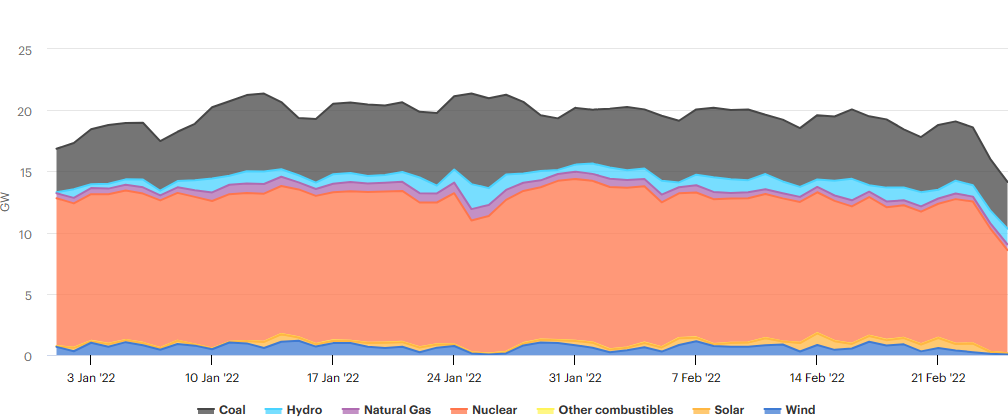
Click to enlarge view. In the IEA’s last public record on February 25, 2022, Ukrainian nuclear plants were producing 8.42GW, coal 3.82GW, hydro 1.28GW, natural gas 0.47GW, solar 0.10GW, and wind 0.04, totaling 14.13GW. For Rozhin’s analysis of how much of this capacity remained before last week’s round of strikes, read this, Rozhin’s estimate of the surviving balance on April 1 was 7.8GW. Based in Paris, the IEA is a propaganda agency for the Kiev regime; Russia is excluded from membership or association. “The IEA is partnering with Ukraine as it bolsters its energy security”, the international agency says on its website at the moment. “The International Energy Agency (IEA), which has deepened its relationship with Ukraine since Russia’s invasion, is stepping up to provide support…The IEA and many of our member countries are working closely with Ukraine to help the country’s energy system recover from Russia’s attacks.” The agency has been concealing the loss of Ukrainian electricity capacity since February 2022.
In remarks this month to the Financial Times of Tokyo and London, Ukrainian energy officials claim they have three alternatives – repair the damage, bringing the system back to normal demand levels; add alternative power sources such as imported electricity from Poland, Hungary, Slovakia, Moldova, Romania, and the Baltic states or local renewables, such as solar and wind generation; or defend the electricity system with more Patriot missile systems.
“Our goal,” according to Maxim Timchenko, chief executive of DTEK — the dominant Ukrainian power company which is owned by Rinat Akhmetov, “is to restore as much as we can by October… Subject to no further attacks, at least 50 per cent of damaged power units will be reconnected to the grid.” Had it not been for the warm weather, energy imports from the EU, and an increase in renewable energy generation, the current situation would be much worse, Timchenko added.
The Russians “are trying to cut off large industrial regions and cities from the power supply,” a spokesman for Ukrenergo, the state-owned grid system operator, told the newspaper. “Smaller substations — managed by Ukrenergo — can be shielded from attacks with protective structures. But it is very difficult, if not impossible to cover the large power plants, which take several months or even years to restore.”
In a separate report, the FT claimed after the Tripolskaya attack that the plant had been “protected by air defences.” Whether these were Patriot missiles or something else, the newspaper omitted to acknowledge that they had been defeated.
It then quoted Ilya Yevlash, Ukraine Air Force’s brand-new spokesman, as saying that “only the Patriot system was capable of shooting down Russia’s hypersonic Kinzhal and Zircon missiles. Obviously we need more, which may help us to protect our critical infrastructure and cities.” The newspaper didn’t ask — Yevlash didn’t say –why the NATO-Ukrainian crews manning the Patriot batteries have been unable to defend either their missile batteries or themselves from hypersonic Kinzhal strikes or the subsonic X-69s.
Other Russian military bloggers are reporting new strikes in the west against thermal power plants (TPP) at Dobrotvir, Lvov region, and Burshtyn, Ivano-Frankivsk region, as well as the vast underground gas storage in Lvov known as Bilche-Volitzko-Ugerskoye.
Alexei Slovtsov has summed up the current situation in the military blog Slavyangrad: “The enemy’s ability to manoeuvre [redistribute and balance] the load has practically disappeared. The base load is carried by the nuclear power plants, and all fluctuations in the schedule can now be covered only by imports from outside. And that is limited by the network bandwidth and power on the other side. The ability to control frequency in the power system will be greatly reduced. The east of Ukraine is now stuck in dependence on several lines of 330 kV and below. There, literally, the last click is needed for everything to go out from the Dnieper to Kharkov. If the 750 kV network is killed, the system will break up into three isolated nodes around the nuclear power plants.” Source: April 12, 01:21.
MAP OF UKRAINIAN TRANSMISSION LINE TARGETS
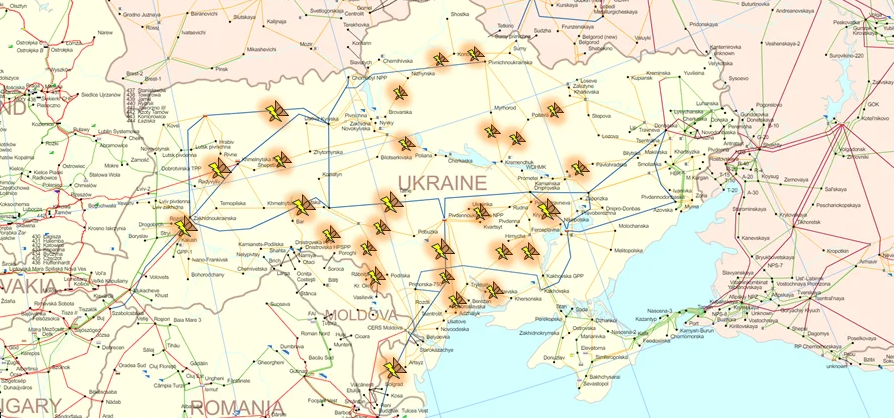
This targeting map was drawn by military sources for this publication on April 1. It is not yet a map of new Russian strikes.
According to a NATO veteran and expert in applying electrical engineering to war, there is no prospect that the regime in Kiev can fill the power hole being created by the Russian operations. “Renewables [solar, wind] are not even remotely close to filling the gap. They’re a scam, especially in the Ukrainian case. Taking generation out of the equation, if the Russians continue striking transmission and distribution infrastructure, as well as production, transportation and storage facilities, the inevitable conclusion is the collapse of the Ukrainian electricity grid. This means the collapse of Ukrainian society. As we watch the electric war unfold, I get the impression that pushing [Ukrainian] people west of the Dnieper is the [Russian] goal of the current phase of the electric war – so call this Phase 2.”
The source said the bordering NATO states lack the capacity to increase their electricity supplies to the Ukraine, even with the addition of newly announced power sources in the Baltic states. This European industry publication has reported that in 2023 Ukrainian imports from the European Union (EU) had doubled from 2021 to 935 million kWh.
How much more EU sources can provide is uncertain. Ukrainian sources told the Financial Times last week that “in the aftermath of the March strikes, imports from the EU reached a record 18,700MWh, the equivalent generated by two power plants. In the months after Russia’s full-scale invasion of 2022, Ukraine connected its grid to neighbouring EU countries Romania, Slovakia, Hungary and Poland.”
The International Energy Agency (IEA), which publishes what it calls “real-time data on electricity demand and generation in Ukraine”, stopped reporting the demand and generation data after February 2022. The US propaganda source, Atlantic Council, is currently claiming that “Ukraine expands EU energy exports in fresh display of wartime resilience”; In fact, Ukrainian electricity exports have stopped, and imports from the EU may already be greater than the Atlantic Council estimated in March to be 1700MW (1.7GW).
Last month, the western press was repeating Kiev’s claims. “In its latest update on energy security in Ukraine, the country’s Energy Ministry said Sunday [March 17] the power supply system remained ‘balanced’ despite technical disruptions and shelling. ‘No shortage of electricity is expected’, it said in a press release on its website. ‘For the current day, electricity imports are expected to reach 3,900 MWh, while exports are also expected to reach 2,000 MWh’ it added. On March 5, 2024, the ministry, which oversees Ukrenegro, said Ukraine achieved an electricity surplus which was exported to Poland in the amount of 246 mWh.”
In the four weeks since then the Russian General Staff have despatched Kinzhal and X-69 to contradict the claims.
The NATO electrical engineer adds: “I don’t believe the transmission lines between the Ukraine and the EU have the capacity for the compensating increase required to fill the gap.”
Oleg Tsarev is an influential Ukrainian political figure and potential Russian candidate to take the presidency in Kiev; he was the target of Ukrainian assassination last October. He now lives and works in Crimea. Here is his Telegram piece of April 7, analyzing the new phase in the electric war: “What has happened? Why have our operations become more striking? Partly this is due to the fact that the Russian Aerospace Forces have pretty much blasted the Ukrainian air defense systems. Since the summer of 2022, the losses of such AFU [Armed Forces of the Ukraine] systems have sharply decreased due to the integration of air defence with Western intelligence systems. Our people looked closely at the western air defence systems, analyzed their work, and looked for vulnerabilities. And so it went on for a long time: for the whole of 2023, according to the official reports of our Ministry of Defense, only 46 anti-aircraft missile systems (SAMs) of Ukraine were hit. And in three months of this year, 52 have already been counted.”
“Our military has studied how Western systems work, how to bypass or hit them. We have improved the quality of the intelligence. The defeats of the SAM on the combat front and in the rear are vivid examples of this. Plus a combination of Geranium drone strikes and rocket launches is used. This is confirmed by the statistics of the General Staff of the Armed Forces of Ukraine in their analysis of combined air strikes and UAVs: if at the beginning of 2023, our [Russian] strikes averaged about 22 per day, then in the middle and end of the year, there were over 50; in February 2024 this number jumped abruptly to 84 per day, and in March the rate continued. Our missiles and drones have really increased. There are fewer enemy air defences.”
“The most important thing is, apparently, that after the attacks on our refineries and on Belgorod, decisions were made to use our capabilities to the fullest. Last year, they [Russia] tried not to hit production facilities, and even blows to large transformers in network nodes were inflicted reluctantly. Today, our weapons are hitting the engine rooms of power plants and any associated military targets. Important political decisions have been made, and all these strikes are just the tip of the iceberg.”
NOTE: The impact of the Tripolskaya, Dobrotvir, and Burshtyn strikes has not yet materialized in a surge of Ukrainians heading out of the blackout and into Poland. These are the latest outward and inward figures issued by the Polish Border Guard:
UKRAINIAN POPULATION MOVEMENT ACROSS THE POLISH BORDER THIS MONTH

As of compilation of these data on April 14, the Polish Border Guard (Straż Graniczna) was lagging in its public reports by three days; in the first year of the war it published these data every day. Source: https://twitter.com/straz_graniczna?lang=en


The last chart on recent population movements shows practically no movement as both in/out are practically the same. Not sure why it’s include or ballyhooed. Nevertheless, it is understood that millions have already left ukraine and probably won’t return.
I was perplexed too. Perhaps he didn’t want to say any of what might be logical surmises:
1. Data being cooked.
2. More Ukrainians being denied entry.
Official border crossings do not capture illegal ones. There may be a lot of Ukrainian men sneaking across the border, or bribing the guards to look the other way.
I have been told that the most popular search on Google in Ukraine at this time is “How to swim across the Tisza”.
I have no idea if or whether that is accurate.
Can they just get some tire inflated tubes? Or children swim tubes?
I understand that those caught doing so are shot at.
You know, “european values” and such forth.
Should it be pointed out that even if there was a conflict freeze right now much to the delight of the west, that they do not have the equipment to repair all the damage done by those Russian strikes. They would have to completely replace the Ukrainian electric grid with western equipment which would be prohibitively expense because of the huge size of the country, assuming that there is the money or even the political will to do so. And at the moment, interest in the Ukraine is dropping off a steep cliff and before too long will be relegated to the back pages before dropping down the same memory hole that Afghanistan did.
Only if they cannot keep a flood of refugees out.
The Mediterranean doesn’t seem to be a barrier, so I am not sure how the Ukrainian border is supposed to work,
I wonder if re-electrification of Ukraine would be “prohibitively expensive,” for the Empire, in these last days of floodgate MMT. We mopes can be sure that the vampire squids, schooling up to recoup their “guaranteed investments” in the lootable assets of 404, will be getting their congresscritters and other stooges in the Three Branches on board to profit from the denouement. Likely there will be a West 404, either “sovereign” or divvied up between Balts and Poles and other hungry beasts, that will need to be “rebuilt.” Not sure what the Russians might have in mind to render the rump leavings of 404 something other than a perpetual playground for the forking scum of CIAMI5-6 to gin up paramilitary bullshit from. And Russian industry might make book on the redo.
We will probably have riots before this happen. As I write there are illegals storming the NYC Townhall. It’s gonna be fun.
I think my previous comment got deleted somehow.
The Russians have made it clear that they will not accept a freeze just because the West is out of ammunition. If there is a freeze, it will be along the Danube.
As for rebuilding Ukraine, the West doesn’t care. The Ukrainians were never anything more than cannon fodder for the West. This is nothing new. The Western world never cared about its Afghan proxies, the South Vietnamese, the Kurds in Iraq, or any other proxy it exploits.
The reality is that the US and Europe are in for harder economic times and there isn’t the mood to spend on building foreign infrastructure, something that increasingly doesn’t even exist in the US and Europe.
The West could care less about the human costs. The economic damage will be cynically used as just a talking point against the Russians, something that few outside the West will accept. The West has lost the Global South and China already.
Along the Danube? I doubt the Russians will get that far, and even thy will get there, Ukraine has only a short border with Romania with the Danube Chilia Arm as a natural border.
I took the OP to mean a literal border at the Danube west of Odessa but there is a figurative Greater Russian-zone border on the Danube in Hungary, Slovakia and Serbia….
Yep. West of Odessa.
Putin has said that Odessa is a Russian city. I think that this would mean that’s what’s left of Ukraine will be the landlocked rump that has previously been discussed here.
There will be a land bridge though to Hungary. I also expect Transnistria will finally be able to join Russia.
If he is the first, then way too many are bad at connecting the dots. :) Those with knowledge of the events of 1999, should know that de-electrification is how NATO managed to force Serbs into signing “peace agreement”. NATO attempts at ground invasion, and destrying military equipment, gave pathetic results (about dozen of tanks, and a square kilometer or so). Even Douglas Macgregor publicly admits that they ran out of military targets, and started destroying bridges and other infrastructure, because they had to bomb something. He still denies DU being bad, probably because that might be a confession usable in court. When they started wrecking power plants, Serbs had to yield. Only Houthis are resistant to that.
That is because pretty much no one in the West wanted to see Russia as competent until recently. Remember all of those poorly led conscripts with no equipment or food, ready to run away at the first sight of Western might? And much more along those lines?
Yet they were going to march to the Atlantic if not stopped in Ukraine, go fig.
Idiot Ruskis wouldn’t know which way to run.
Or how weak NATO really is. So now, just by panicking and running the wrong direction they’re over-running Ukraine.
The MSM narrative makes perfect sense.
“You just can’t expect a bunch of ignorant peons to understand a machine like some of our boys. That’s not meant as an insult, Mr. Ambassador. I mean, you take your average Russki, we all know how much guts he’s got. Hell, look at all them Nazis killed off, and he still wouldn’t quit.”
. . .says Buck Turgidson
There were other factors at play in 1999, deelectrification was a minor part of it. The key was that Milosevic family was guaranteed safe haven in Russia and immunity in the US and EU, protecting their financial assets. Similar deals were made for other key Serbian officials.
Alternative was that US would support a coup executed by Jovica Stanisic and Milorad Ulemek, heads of the state security and special operations unit, both of which have been working for the CIA. Milosevic government was highly unpopular even before the war, sort of the same situation Netanyahu is in right now, and would be overthrown with Ulemek’s assistance the following year. Milosevic was almost overthrown a couple of years earlier, during 1996/97 protests, only holding on to power with support from the US and EU who preferred a weak Milosevic government that was easily controlled.
So Milosevic government was like Abdrabbuh Mansur Hadi, who fought against Houthis with foreign support, rather than a broadly popular movement like the Houthis.
That’ll make the Ukrainians happy, first they’ve got no electricity but it doesn’t matter much since this will end dead one way or another anyway, remember this war ends with the last Ukrainian anyway. America has decided and $61 billion ‘Aid’ or not there’s enough left to bribe/threaten those who count. A few million might freeze to death this winter to hurry things up a bit.
Electrification, evoking stories from nearby Romania during the Ceauşescu regime with that 40-watt bulb on up to a generous 4 hours per day. Lampposts, symbolically not just for Mussolini anymore.
Gets me thinking about this vague memory about a hidden water pump found in some river in northern Iraq after the invasion. Something about it being remotely operated from Baghdad, denying the locals drinking water at will.
Vague memory about babies stolen from incubators and chemical wepons.
Highly exagerated stories. If power was cut was in the countryside, and during nightime, wen pople had to sleep anyways. They were encouraged to go to sleep earlier, especially during winter. And there were light bulbs of 60W and 100W as well.
And that wasn’t the biggest problem in the countryside. Purchasing firewood for the winter period was far more pressing a problem. But that wood was growing in the forest…
So, after developing an empirical response electrical model of the Ukrainian grid, Russia dropped it to the point that the overall Ukrainian grid can (mostly, not in Kharkov) support basic electric needs but not transportation and manufacturing.
After the next grid hits (after Helmer, it seems likely Russia now is learning how the EU grid adapts to the Ukrainian draw) reduce production by another 5-10?%, will we see rolling blackouts in neighboring EU countries that will face the political fallout whatever decision they take?
If that happens, the European countries will cut off Ukraine from their Grids and Ukraine will be going dark in many affected areas.
The Europeans don’t care about Ukraine. They just used them to weaken the Russians, which backfired.
In Ukraine, where de-Sovietisation is underway, is there any reason why Russians should not be welcome to dismantle the legacy of communism at their own expense?
Next up on the juke box, Dandy Don with “Turn Out The Lights, The Party’s Over”.
Should have been done long ago, along with a relentless SEAD campaign, destruction of communications infrastructure, bridges, locomotives, etc..
Anyway, Ukraine will get its money from Congress, which will keep it in the fight a while longer before european NATO members can be goaded in once Ukraine runs out of warm live bodies.
Money means nothing if it does not provide weapons, which it won’t in the numbers they need.
But what are they going to do about it?
I said nothing about weapons. I said that the money will keep the fight going for a while.
Although we have been hearing for two years now that the West is out of weapons (and that Russia is out of everything from men to oil to missiles to ships to washing machines to shovels to burrito coverings). But somehow, nether ever quite seems to materialize.
Ukraine seems to be still well provisioned with drones, at least in the southern areas.
That is my point – money alone won’t keep the fight going.
We’ve reached the point were money does no good unless it leads to weapons. And yes, the West is out of weapons, at least when it comes the the levels needed to sustain a war in Ukraine.
There seems to be something peculiar going on with the Ukrainian military (MoA is not the only place where this came up: others have been noting that the “ultranationalist” militias are on the outs politically in Ukraine since Zaluzhyi have been out.)
https://www.moonofalabama.org/2024/04/ukraine-sitrep-the-power-plant-war-ideological-losses-more-signs-of-corruption.html
The implication of this is that the “Russians” in charge of Ukraine are doing a pretty decent job “de-Nazifying” their country. At minimum, Syrsky is much more aggressive using these guys in combat, in situations where they are likely to suffer heavy losses, while Zaluzhnyi was quite insistent in keeping them out of combat as much as possible. For what it’s worth, the ethnic dimension does seem to remain an important factor in alignment of Ukrainian politics: the “Ukrainians” never liked the “Russians” much and, possibly, were always plotting to overthrow the latter if something was amiss (e.g. all the tooth gnashing between Poroshenko/Zaluzhnyi and Zelensky a little while ago). Hardly a sign that the Ukrainian “Russians” are necessarily favorably disposed towards Russia, of course, but one should think that the decimation of the Ultranationalist factions–who were never really that big in terms of numbers in Ukraine–has to have an interesting impact in medium to long term.
The Banderists are a bigger threat to the Zelensky regime than the Russians are and have previously threatened him. Russia has been careful not to hurt Zelensky and forbade their troops from doing so even when they have had a clear shot.
So getting rid of them is essential for Zelensky. I suspect that another reason that Syrsky can safely use these troops is that Ukraine has so few men left, so be has the perfect excuse.
As a side note, it’s not just that Lenin said “Communism is Soviet power plus the electrification of the whole country”, but also that the slogan was endlessly mocked in later decades, by treating it as an equation.
So we have:
Communism = Soviet power + electrification
=>
Electrification = Communism minus Soviet power
and
Soviet power = Communism minus electrification
This is why it has been coming back again and again since October 2022.
Years ago, in a forbidden building in Kiev (long story and funny, but less cloak and dagger than you might think – I was buying used furniture) I saw a beautiful mural with that slogan.
The view from the top floor of the building was tremendous. I can see why it was forbidden.
I fail to see what there is to mock though. The Bolsheviks dragged Russia out of being a backwards wasteland. They electrified the country. The entire reason modern Russia is anything is built on the back of that residual soviet legacy.
You can swap words around to try to make fun of it, but there’s nothing to actually mock or satirize. There’s no substance to the word games, leaving the exercise hollow and pathetic.
Note that historically I am close to 100% on the side of the Bolsheviks.
But it is a fact that Soviet propaganda became increasingly clumsy, obtuse and ineffective over the decades, and that is why people started mocking it. Eventually they went back to famous slogans from the past, when the uplifting revolutionary spirit was still in full swing, and mocked those too. That joke isn’t from the early 1920s.
There was, apparently, the famous triple bed for newlyweds because “Lenin is always with us”
So many decades ago (I hate to say how many) I studied and wrote on socialist realism, and I recall Lenin’s emphasis was on … electrification! A common example was, if you painted a lovely picture of a rural area, you would show how communism transformed the area (people’s lives) by adding transformers and electrical lines.
Thank you for reminding me of Roosevelt’s TVA and Rural Electrification Program and how vastly that changed the South.
From a Ukraine perspective, the obvious requirement is to take out the archer, not the arrow. That requires something like F-35 in sufficient numbers to counter the Su-34/Su-35, though the capability of F-35 against these fighters remains something of a question mark.
I like the idea of a scenario where the F-35s aren’t immediately murdered by a multi-layered Russia air defense network because stealth doesn’t actually work.
Also the Su-34 is primarily a bomber. Not sure why you imagine it would be dogfighting when more capable aircraft are avaliable.
The Russians are shooting from within their borders, and have S400 to keep the F35 well in check. And the MIGs have some air to air missiles that outrange what F35 has, or so is my understanding.
F-35s alone won’t do much, they will be shot down just as quickly as the Ukrainian MiG-29s and Su-27s.
The question is whether they have ultra-long-range air-to-air missiles. Russian Su-35s and MiG-31s have the R-37M with range of 400 km. Officially NATO has nothing comparable in the arsenal, only stuff that goes half that distance.
P.S. Having said that, Ukrainians are somehow still flying MiG-29s and Su-27s more than two years into this. But F-35s likely won’t be able to do the same, because the reason there are still surviving MiG-29s and Su-27s is that they can operate from anywhere — air strips in seriously decrepit condition, highways and secondary roads, etc.
The F-35, on the the other hand, is a fragile and sensitive hangar queen.
P.P.S What the Ukrainians need in military-technical terms is long-range ballistic missiles to take Russian airfields and the planes parked there. But the moment that is attempted, WWIII starts. In fact, going by Russian doctrine, ICBMs should be firing towards Europe and North America while those missiles are still in flight towards their targets in Russia. Because the Kremlin cannot assume the warheads are conventional and has to treat it is a nuclear first strike and respond with a second strike.
I doubt very much that Rozhin’s blog “broadly represents General Staff thinking”. He’s originally a comics, scifi and military history blogger from Sevastopol*. Very pro-Russian and very pro-Stalin even before 2014.
His comments/analyses are at best when he recites what his contacts on the front lines have told him – and he knows a lot of people since the “Russian Spring”. But other than his military history hobby and his contacts on company and battalion level in former Donbass militias, he has no more military access or training than most of us here.
Martyanov, of course, thinks he’s mere charlatan. I do see some value in his comments, though I bother to check them quite rarely nowadays.
* born in 1981, he would have served in Ukrainian army as a conscript, but since by 2001 UAF had shrunk to about 1/4 of what it was in 1991 (~80,000 conscripts/year), it’s possible that he didn’t serve at all.
Does Martyanov think there’s anyone who is not a charlatan? There are times when I wonder if he thinks he, rather than Gerasimov, should be the chief of general staff of RF…..
Meh, I’m not buying it, mostly because of the timing. IMO, the new attacks on the Ukrainian grid are a direct response to recent Ukrainian attacks on energy infrastructure inside [pre-2022] Russia.
That was Putin’s first explanation for the new attacks. Of course that could be cover for Helmer’s angle, but the *timing* supports my theory much better. A year or two ago, Russia made a few attacks on Ukrainian electric transmission sites, but those stopped fairly quickly; that always seemed to me like Warning Shots, rather than a tactical move supporting a general strategy.
If I’m right, we will see a pause in Russian attacks on the Ukie grid, waiting to see if Ukraine attacks inside Russia again. If they do, Russia would renew the grid bombing, at 2-3x the recent intensity & breadth. If Ukraine gets the message and stops attacks inside Russia, I expect Russia to stick to the ground game, grinding out yards & grinding up Ukrainian troops, but generally not bombing civilian (or mixed-use) infrastructure in Western Ukraine.
I am still waiting for Western businesses to vacate Kiev en masse like Starbucks and McDonalds closing down operation due to lack of electricity etc. People in that city won’t get the message until that happens.